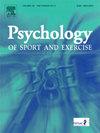The prospective associations between internalized weight bias and physical activity among adolescents
IF 3.1
2区 心理学
Q2 HOSPITALITY, LEISURE, SPORT & TOURISM
引用次数: 0
Abstract
This study examined the associations between internalized weight bias and physical activity (resistance training, moderate-to-vigorous physical activity; MVPA) across weight perceptions over one year among Canadian adolescents. Participants in Years 10 (T1; 2021–2022) and 11 (T2; 2022–2023) of the COMPASS study completed a cross-sectional self-report survey each year (N = 23,574, Mage = 14.3 (SD = 1.2), 51.5 % cisgender girls). Linear mixed effects multilevel models stratified by weight perception (underweight, about the right weight, overweight) tested the association between T1 internalized weight bias and T2 physical activity after controlling for province, gender, ethnicity, perceived affluence, age, and T1 physical activity. Adolescents with overweight perceptions reported higher internalized weight bias (ηp2 = .05) and lower MVPA (ηp2 = .004) and resistance training (ηp2 = .01) than adolescents with lower-weight perceptions. For adolescents with underweight and about the right weight perceptions, internalized weight bias was associated with more MVPA [b(SE) = 6.8(3.0); 3.7(1.4)] and resistance training [b(SE) = .33 (.12); .11(.06)] one year later compared to adolescents reporting no internalized weight bias. Physical activity levels were not different across levels of internalized weight bias among adolescents with overweight perceptions. The differing associations between internalized weight bias and physical activity across weight perceptions may relate to broader anti-fat attitudes and experiences of stigma that uniquely impact adolescents with overweight perceptions. Future research should consider the physical activity motivations associated with internalized weight bias.
青少年内化体重偏见与身体活动之间的前瞻性关联
本研究考察了内化体重偏见与身体活动(阻力训练、中高强度身体活动;MVPA)对加拿大青少年体重认知的影响。10年级(T1;2021-2022)和11 (T2;(2022-2023),每年完成一项横断面自我报告调查(N = 23,574, Mage = 14.3 (SD = 1.2), 51.5%为顺性别女孩)。在控制省份、性别、种族、感知富裕程度、年龄和T1体力活动后,由体重感知分层(体重不足、体重适中、体重超重)分层的线性混合效应多层模型检验了T1内化体重偏差与T2体力活动之间的关系。与体重知觉较轻的青少年相比,有超重知觉的青少年的内化体重偏差较高(ηp2 = 0.05), MVPA (ηp2 = 0.004)和阻力训练(ηp2 = 0.01)较低。对于体重过轻且体重认知不正确的青少年,内化体重偏见与MVPA增加相关[b(SE) = 6.8(3.0)];3.7(1.4)]和阻力训练[b(SE) = .33 (.12);.11(.06)]与没有内化体重偏见的青少年相比。在有超重认知的青少年中,身体活动水平在内化体重偏差水平上没有差异。在体重认知中,内化体重偏见和身体活动之间的不同关联可能与更广泛的反肥胖态度和污名化经历有关,这些态度和经历对超重认知的青少年有独特的影响。未来的研究应考虑与内化体重偏见相关的体育活动动机。
本文章由计算机程序翻译,如有差异,请以英文原文为准。
求助全文
约1分钟内获得全文
求助全文
来源期刊
CiteScore
6.40
自引率
5.90%
发文量
172
审稿时长
69 days
期刊介绍:
Psychology of Sport and Exercise is an international forum for scholarly reports in the psychology of sport and exercise, broadly defined. The journal is open to the use of diverse methodological approaches. Manuscripts that will be considered for publication will present results from high quality empirical research, systematic reviews, meta-analyses, commentaries concerning already published PSE papers or topics of general interest for PSE readers, protocol papers for trials, and reports of professional practice (which will need to demonstrate academic rigour and go beyond mere description). The CONSORT guidelines consort-statement need to be followed for protocol papers for trials; authors should present a flow diagramme and attach with their cover letter the CONSORT checklist. For meta-analysis, the PRISMA prisma-statement guidelines should be followed; authors should present a flow diagramme and attach with their cover letter the PRISMA checklist. For systematic reviews it is recommended that the PRISMA guidelines are followed, although it is not compulsory. Authors interested in submitting replications of published studies need to contact the Editors-in-Chief before they start their replication. We are not interested in manuscripts that aim to test the psychometric properties of an existing scale from English to another language, unless new validation methods are used which address previously unanswered research questions.

 求助内容:
求助内容: 应助结果提醒方式:
应助结果提醒方式:


